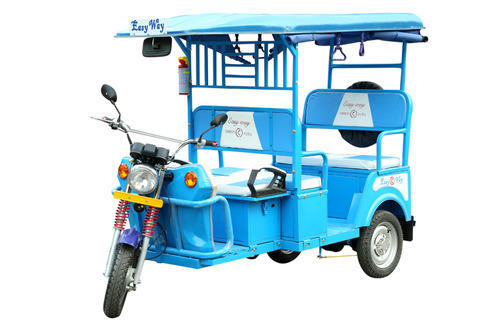India has more e-rickshaws than China's e-vehicles fleet
The South Asian nation is home to about 1.5 million battery-powered, three-wheeled rickshaws – a fleet bigger than the total number of electric passenger cars sold in China since 2011. But while the world’s largest auto market dangled significant subsidies to encourage purchases of battery-powered cars, India’s e-movement hardly got a hand from the state.
As many as 11,000 new e-rickshaws hit the streets every month, and annual sales are expected to increase about 9 per cent by 2021, according to consulting firm A.T. Kearney. Three-wheeled vehicles make up a $1.5 billion market, and manufacturers of electric versions include Mahindra & Mahindra Ltd and Kinetic Engineering Ltd, along with smaller outfits that assemble parts imported from China.
“This is a once-in-a-lifetime, transformational opportunity that we’re looking at," said Goldie Srivastava, chief executive officer and co-founder of SmartE, an Uber-style app using 800-plus e-rickshaws around New Delhi. “When we look at electric mobility, the focus should be: Are you as a government enabling products that are designed for the future?"
India’s dominant ride-hailing startup, Ola, plans to place 10,000 e-ricks in its service by next April.
“This is a once-in-a-lifetime, transformational opportunity that we’re looking at," said Goldie Srivastava, chief executive officer and co-founder of SmartE, an Uber-style app using 800-plus e-rickshaws around New Delhi. “When we look at electric mobility, the focus should be: Are you as a government enabling products that are designed for the future?"
India’s dominant ride-hailing startup, Ola, plans to place 10,000 e-ricks in its service by next April.
Prime Minister Narendra Modi’s administration now is pivoting toward promoting EVs in public transportation and fleet operations – primarily, two- and three-wheelers, taxis and buses. The ministry of finance is finalising a plan to spend about Rs 4,000 crore ($600 million) in the next five years to improve the nation’s charging infrastructure and subsidize e-buses.
“India needs to focus on electrifying two-wheelers and three-wheelers,’’ said Amitabh Kant, chief executive of NITI Aayog, a government policy institute helping formulate the new strategy.
Outside an east Delhi metro station, a slew of partly open-air vehicles line the street as commuters hail their rides. They also carry tourists, schoolchildren, crates of fruit and the occasional goat.
Anil Chaudhary, 32, switched to an e-rickshaw from a cycle model two years ago. His income increased, he’s able to take longer breaks and he sends money to his wife and three children in Bihar, about 700 miles away. He’s already on his second electric model.
“India needs to focus on electrifying two-wheelers and three-wheelers,’’ said Amitabh Kant, chief executive of NITI Aayog, a government policy institute helping formulate the new strategy.
Outside an east Delhi metro station, a slew of partly open-air vehicles line the street as commuters hail their rides. They also carry tourists, schoolchildren, crates of fruit and the occasional goat.
Anil Chaudhary, 32, switched to an e-rickshaw from a cycle model two years ago. His income increased, he’s able to take longer breaks and he sends money to his wife and three children in Bihar, about 700 miles away. He’s already on his second electric model.
How to make e-rickshaws?

